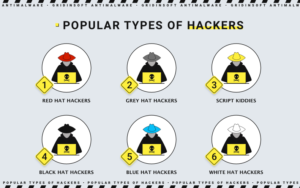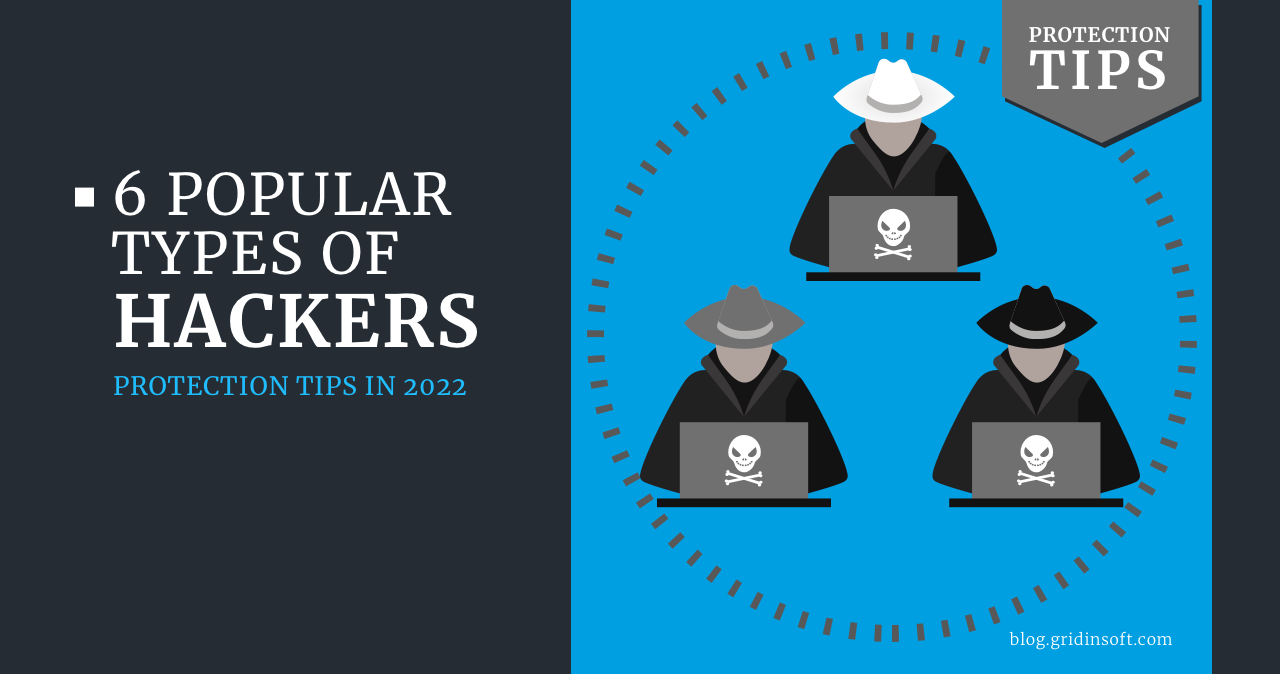The internet has given us many wonderful things: smart homes, NFTs, cryptocurrency, and more. Without our connection to the internet, the world would be a much different place today. Unfortunately, this digital age has also spawned different types of hackers who want to ruin our cyber safety experiences.
We’ve had as much time learning how to protect ourselves and our devices as they’ve had to figure out their hacking methods. In this article, you’ll learn about the different types of hackers, such as black, white, red, gray, blue and script. Also about their reasons for hacking, and some ways to protect your identity and devices against hacking.

Black Hat Hackers
Black hat hackers are the epitome of cybercrime. They break into personal devices and networks to steal valuable information they can sell for their gain. In addition, black hat hackers use nefarious cyberattacks, such as spyware and ransomware, to acquire their targeted data.
In early 2021, the NBA Houston Rockets basketball team had their computers hacked by black hat hackers. The hackers used ransomware to steal over 500 GB of contracts, NDAs, and personal financial information. The hackers threatened to release the stolen information if blackmail money was not paid, which many believed caused the 2021 NBA lockout.
White Hat Hackers
The skills of white hat hackers are like those of black hat hackers. But the difference between them is their usage of knowledge of hacking to break into systems to find security holes and help with preventing cyber attacks rather than harming the companies. They help governments, businesses, and everyday people keep their information safe.
Companies hire white hackers after a cyber attack, or to control security after the introduction of new software. Instead of upgrading the entire network, a business could hire a hacker to look for potential issues that hackers could exploit.
Red Hat Hackers
Red hackers who hack systems like white hackers, but they do the work for themselves, not for government or business clients. The Red hats are hunting hackers who attack for profit – that is, blackhats. They do it to return the loot to the victims.
Gray Hat Hackers
Some hackers only hack for fun, and they are called gray hackers. These hackers enjoy finding security gaps in networks and might even let the network know they found a gap. Some people find Gray hackers frustrating because they hack private networks without being allowed to.
More than 100,000 private routers were hacked in 2018 by a Russian-speaking gray hat hacker. Although many people thought they were up to no good, it was revealed that they were fixing security vulnerabilities in the routers to protect the devices from other hackers and cyber threats, such as crypto hackers.
Blue Hat Hackers
Blue hat hackers are very similar to white hat hackers. Still, instead of hacking into systems or software that the company is already using, companies give blue hat hackers access to the software in advance to review the security setups. This allows organizations to reduce potential risks. To fully understand how it works, imagine a company that wants to launch new software. Before doing so, she hires a hacker to test the system to prevent a potential hack. Then, the program is run for use if the final test result is positive.
Script Kiddies
Script hackers always try to take someone’s hack script so as not to create their own.This type of hacker also doesn’t have the same skills as black hat hackers. However, instead of learning how to create their malware, they will copy existing ones already created by more experienced hackers.
In 2015, such a case occurred in Ireland with a 15-year-old arrested by the police for violating the company’s private property. So the guy broke the computer malpractice law. Moreover, this little scammer held on to personal data to get a ransom for them and used that confidential data with malicious software.
How to Prevent Hackers
Given that not all hackers work against the user, you still need to know the rules about protection against hacking.
- Keep personal information safe. From the above list, it became clear that some hackers target sensitive data for malicious purposes. You can complicate the attacker’s task by not including your personal information in online profiles. If you need to send your data to someone, ensure the recipient is legitimate.
- Avoid public Wi-Fi. Some hackers use public Wi-Fi networks to infect devices with various malware. So if you are out of the house, use a secure network. To do this, look for “http” in the URL and various security signs. This will be a good sign that your site is secure.
- Consider using a VPN. Using a VPN will help you encrypt your files. This makes it difficult for an attacker to track your page history and IP address. It is also a good way to avoid spyware or adware.
- Use secure passwords. The first defense against cyber attacks is passwords. Unfortunately, password spraying or credential dumping is a common method of capturing user data. Here it would help if you chose a more robust password with different characters, letters, and numbers combinations.
- Enable two-factor authentication. To ensure an additional level of security, use two-factor authentication. It has a biometric technology that can protect your credentials with various technologies. Such as fingerprints, facial recognition, and additional I.D.s.
- Download Antivirus Software. Don’t forget to install antivirus software. It will protect your devices and data. In this way, hackers will have less chance to make a successful attack.




